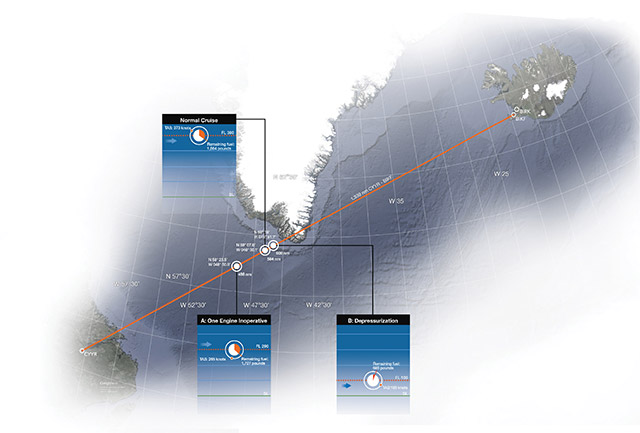
Point A shows the ETP for an engine failure event, assuming the remainder of the flight will occur at the single-engine ceiling of FL290. Strong west-to-east winds aloft mean the aircraft can travel the more than 800 nautical miles to Iceland in the same time as the 500 nm back to Goose Bay. Point B shows the ETP for a depressurization, with the diversion occurring at 10,000 feet.
Over the North Atlantic, you begin to wonder: Will I have enough fuel to reach the destination?
Pilots planning international flights often have alternate airport planning challenges far trickier than those encountered domestically. A pilot crossing the North Atlantic, for example, may face situations wherein a destination in Canada or Greenland may not have a suitable alternate for more than 300 nautical miles. As if the scarcity of alternates isn’t challenge enough, pilots flying long overwater routes face an additional planning hurdle: calculation of equal time points (ETPs).
An ETP is simple in concept. It is the point on a route where an aircraft would require exactly the same amount of time to fly to either one of two specified airports. If winds aloft were calm, it would simply be the point where the distance to the two airports is equal. As winds increase, it is intuitive to grasp that the ETP will shift toward the upwind airport on the route: A 100-knot tailwind aloft means that well before the halfway point of a route, a pilot can get to the destination more quickly than turning around and flying back into a 100-knot headwind to return to the departure airport.
For a two-airport leg, the formula to calculate an ETP is simple: The distance between the airports is multiplied by the groundspeed (GS) the airplane would experience if it returned to the departure airport. This product is then divided by the sum of the groundspeed to return and the groundspeed to continue: DistancexGSreturn)/(GSreturn+GScontinue). The result is how far from the departure point the ETP lies.

If only the situation were this simple. Complicating matters is that often, a third diversion airport lies well off the route—but is a bit closer at the halfway point than either the departure or destination airport. In this case, multiple ETPs are calculated: one for where a return/diversion will take the same amount of time, and again for where a continue/diversion will take the same amount of time.
If you’ve wrapped your head around that, hang on, as the plot further thickens. There are three broad reasons a jet might be faced with a need to get to an airport ASAP: a medical emergency (or any other emergency that doesn’t affect the speed or cruise altitude of the airplane), an engine failure, or a cabin depressurization.
The trick is that each of the three scenarios will be flown at different altitudes: The medical emergency can typically be flown at the normal cruise ceiling; the engine failure will result in the aircraft “drifting down” to an altitude in the 20,000 feet to 30,000 feet range, and the depressurization could require the aircraft to descend all the way to 10,000 feet. For each of these altitudes, the speed the aircraft flies and the winds encountered will be very different, so a separate ETP must be calculated for each possibility, using the winds and airspeed for the specific scenario. Sometimes the various ETPs lie close together; sometimes they are quite far apart.
In addition to telling the pilot where a turnaround no longer makes as much sense as continuing to the destination, calculation of ETPs serves another critical purpose: avoiding a “wet footprint,” or situation in which an engine failure or depressurization could result in the aircraft running out of fuel before making it to an airport. For the ETP calculations shown on page T–5, the most critical situation for this theoretical flight from Goose Bay, Newfoundland, to Reykjavík, Iceland, with an alternate at Keflavik, is a depressurization event at the ETP requiring three hours and 19 minutes of flight at 10,000 feet. That would leave the aircraft with only 685 pounds of fuel on landing—acceptable but below the normal reserves for this airplane of 800 to 1,000 pounds.
Contrast this 685 pounds remaining with the more than 1,700 pounds the airplane would have if it went missed at its destination and diverted to the filed alternate, and it’s clear that comprehensive ETP calculations are not to be overlooked. If a pilot accepted a flight plan looking only at the alternate fuel planning needs, he might be comfortable with reserve fuel much lower, not realizing that in a depressurization event the airplane wouldn’t be carrying enough fuel for prolonged flight at low altitudes, and could in the worst case end up wet indeed. Fortunately, all major international flight planning services provide ETP calculations with their service; the pilot need only confirm the information is valid.
Neil Singer is a Master CFI with more than 8,500 hours in 15 years of flying.


